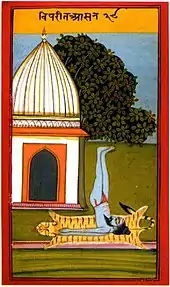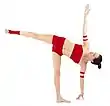Viparita Karani
Viparita Karani (Sanskrit: विपरीतकरणी; IAST: viparītakaraṇī) or legs up the wall pose[1] is both an asana and a mudra in hatha yoga. In modern yoga as exercise, it is commonly a fully supported pose using a wall and sometimes a pile of blankets.

Etymology and origins

The name comes from the Sanskrit words विपरीत viparīta, "inverted" or "reversed", and करणी karaṇī, "a particular type of practice".[2]
The practice is described in the 13th century Vivekamārtaṇḍa as a means of yogic withdrawal, pratyahara.[3]
The pose was practised from the 17th century onwards in hatha yoga under names such as Narakasana, Kapalasana and Viparitakaranasana; its purpose as a mudra was to reverse the downflow and loss of the life-giving substance (amrita) through the use of gravity.[4]
Description
Viparita Karani can be any practice where one is upside down. This can include the asanas of shoulder stand (Sarvangasana), headstand (Sirsasana), or handstand (Adho Mukha Vrksasana). In the Hatha Yoga Pradipika, as in most classical texts on haṭha yoga, viparita karani is listed as a mudra,[5] meaning its purpose is for the directing of energy or kundalini upwards within the body, using gravity,[6] as opposed to asanas which are used in the Hatha Yoga Pradipika to create steadiness.[7]
In one popular expression of viparita karani as an asana in modern postural yoga, it resembles Salamba Sarvāngāsana (supported shoulder stand) but with extension in the thoracic spine (rather than the cervical spine, elbows on the floor and hands supporting hips or lower back.[8] In Iyengar Yoga, the pose is described as "a restful practice, where the body is inverted without effort", and the lower back and buttocks are supported with a pile of blankets, while the legs are rested against a wall. Alternatively the back can rest on the floor and the legs point straight up (also called Uttanapadasana), either against a wall or free.[2]
Variations
Variations include bringing the soles of the feet together as in Baddha Konasana, or letting the legs fall outward into a straddle.
In Urdhva Prasarita Padasana, the back is on the ground, the arms are above the head, and the legs are raised either partly or to the vertical.[9]
References
- YJ Editors (28 August 2007). "Legs-Up-the-Wall Pose". Yoga Journal.
- Mehta 1990, p. 122.
- Westoby, Ruth (October 2019). "The Viveka-mārtaṇḍa on pratyāhāra in viparītakaraṇī with James Mallinson". SOAS, University of London. Retrieved 14 November 2020.
- Mallinson & Singleton 2017, p. 90.
- Hatha Yoga Pradipika III.7
- Hatha Yoga Pradipika III.5
- Hatha Yoga Pradipika I.19
- "Viparita Karani Mudra (Upside Down Seal)". Yoga Art and Science. Retrieved 21 August 2012.
- Mehta 1990, p. 84.
Sources
- Mallinson, James; Singleton, Mark (2017). Roots of Yoga. Penguin Books. ISBN 978-0-241-25304-5. OCLC 928480104.
- Mehta, Silva; Mehta, Mira; Mehta, Shyam (1990). Yoga: The Iyengar Way. Dorling Kindersley.
Further reading
- Iyengar, B. K. S. (1 October 2005). Illustrated Light On Yoga. HarperCollins. ISBN 978-81-7223-606-9.
- Saraswati, Swami Janakananda (1 February 1992). Yoga, Tantra and Meditation in Daily Life. Weiser Books. ISBN 978-0-87728-768-1.
- Saraswati, Swami Satyananda (1 August 2003). Asana Pranayama Mudra Bandha. Nesma Books India. ISBN 978-81-86336-14-4.
- Saraswati, Swami Satyananda (January 2004). A Systematic Course in the Ancient Tantric Techniques of Yoga and Kriya. Nesma Books India. ISBN 978-81-85787-08-4.
_from_Jogapradipika_1830_(detail).jpg.webp)

